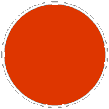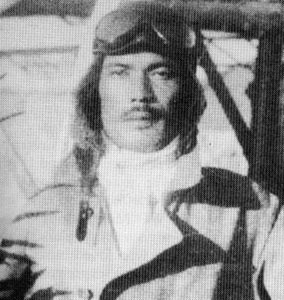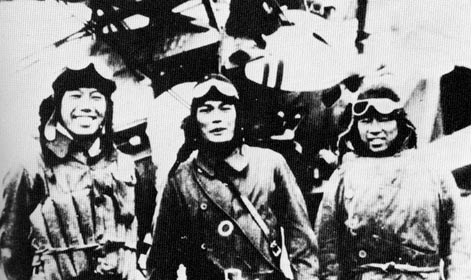Japan

Hiko Heisocho Toshio Kuro-iwa
Japan

Hiko Heisocho Toshio Kuro-iwa

Toshio Kuro-iwa was born in Fukuoka Prefecture on 25 December 1908.
He enlisted into the navy in 1926 and was one of the earliest fighter pilots when he graduated with the 13th Pilot Training Class in December 1928.
He was transferred to the aircraft carrier Kaga’s fighter squadron.
With the outbreak of the first phase of the Shanghai Incident on 29 January 1932, the 1st Koku-sentai (Carrier Division) (of which Kaga was the flagship and including Hosho) was posted to the 3rd Fleet and operated off Shanghai.
On 7 February, a Hikokitai (a detachment of a carrier group) under the command of division officer Lieutenant Yoshitane Yanagimura established its base in Shanghai at Kunda airfield and was used primarily in support of land operations.
On 22 February, three Type 3 carrier fighters (Nakajima A1N - a variant of the Gloster Gambet) under the command of shotai (section) leader Tai-i (Lieutenant) Nokiji Ikuta (second aircraft flown by Santo Koku Heiso (Aviation Petty Officer, 3rd Class) Kuro-iwa and third flown by Itto Kokuhei (Aviation Seaman, 1st Class) Kazuo Takeo) joined three Mitsubishi Type 13-3 (B1M) carrier attack aircraft under the command of shotai leader Tai-i Susumu Kotani.
They engaged a Chinese Boeing 218 (the prototype for the P-12) piloted by the American Robert Short. Tai-i Kotani was killed and his radio operator/gunner A1c Sasaki was badly injured during this attack before Ikuta attacked Short’s aircraft from the rear. At the same time, the aircraft flown by Kuro-iwa came in close under the rear of the enemy aircraft. Both Japanese aircraft opened fire and the Boeing was shot down.
The Mitsubishi commanded by Kotani was flown back to its base at Shanghai by the pilot ACPO Yoshiro Sakinaga.
Taisho (Admiral) Nomura of the Third Fleet issued commendations on the occasion.
This battle result is officially recognized as the first aerial victory by the Japanese air forces.
A cease-fire on 3 March ended the Shanghai Incident.

He later took part in the Sino-Japanese war in the spring of 1938, belonging to the 12th Kokutai.
On 25 February 1938, 35 land based G3M2s from the IJNAF escorted by 18 Japanese A5Ms from the 12th and 13th Kokutais attacked Nanchang. The escort intercepted a reported 50 I-15s and I-16s and in the ensuing combat the Japanese pilots claimed 42 victories and 13 probables (according other sources 27 victories were claimed). Victories were claimed by PO1c Kuro-iwa of the 12th Kokutai, who claimed two, PO1c Sada-aki Akamatsu of the 13th Kokutai, who claimed his first four victories (of a total of 27 – 11 in China), Shigetaka Omori of the 13th Kokutai, who claimed his first victory (of a total of 13 – 1 in China), Kiyonobu Suzuki of the 13th Kokutai and Tetsuzo Iwamoto of the 12th Kokutai, who claimed his first five enemy aircraft (he was later to be the top-scoring pilot of the China Incident with 14 victories and a total of approx. 80). Momoto Matsumura of the 12th Kokutai, who flew as number three in PO1c Tomokichi Arai’s unit, single-handedly claimed his first four and three probable enemy aircraft (of a total of 13 – 10 in China). PO2c Koizumi of the 12th Kokutai flew as a shotai leader and claimed his first two enemy fighters (of a total of 13 – 2 in China). Two Japanese pilots were lost when division officer Lieutenant Shigeo Takuma (57th Class) of the 13th Kokutai and PO1c Hisao Ochi (Pilot Training class 31) were killed. Suzuki who flew as number two wingman to Takuma was wounded in this combat.
According to Chinese records, the intercepting Chinese pilots claimed three victories and lost six aircraft.
According to Russian sources, the Soviet volunteer Nikolai Alekseevich Smirnov is listed as killed on 25 February and buried at Nanchang, together with leytenant Nikolay Ivanovich Vasil’ev and Sergey Dmitrievich Smirnov, also killed on this date. It is however also possisble that Smirnov, together with Nikolai Smirnov was killed on 18 February over Hankow. It is known that the following Russian piloted fighters were shot down (I-15bis no. 5807, I-15bis no. 5812 pilot killed, I-15bis no. 5813 pilot killed, I-15bis no. 5850 pilot wounded, I-15bis no. 5858, I-16 no. 5339 damaged, I-16 no. 5365 pilot killed).
The Nanchang airfield was hit hard with one SB (no. 1532) destroyed.
Nikolai Smirnov (born 1907), leytenant Vasil’ev (born 1909) and leytenant Sergey Smirnov (born 1908) were decorated with a posthumous Order of the Red Star later in 1938.
He exhibited his daredevil skill during a three-month period of action in the central China battlefront when he shot down 11 more enemy aircraft.
He left the service in 1939 and entered the reserves.
Entering the Dai Nippon Koku (“Greater Japan Airlines”) firm, Kuro-iwa was engaged in transport operations.
On 26 August 1944, however, he was lost off the Malay Peninsula and is deemed to have died in the line of duty.
At the time of his death, Kuro-iwa was credited with 1 shared biplane victory and a total of 13.
Claims:
| Kill no. | Date | Number | Type | Result | Plane type | Serial no. | Locality | Unit |
| 1932 | ||||||||
| 22/02/32 | 1/2 | Boeing 218 (a) | Shared destroyed | Nakajima A1N | Shanghai area | Kaga FS | ||
| 1938 | ||||||||
| 1 | 25/02/38 | 1 | Enemy aircraft (b) | Destroyed | Mitsubishi A5M | Nanchang area | 12th Kokutai | |
| 2 | 25/02/38 | 1 | Enemy aircraft (b) | Destroyed | Mitsubishi A5M | Nanchang area | 12th Kokutai |
Biplane victories: 1 shared destroyed.
TOTAL: 13 and 1 shared destroyed.
(a) American volunteer Robert Short shot down.
(b) Japanese pilots from the 12th and 13th Kokutais claimed 42 victories and 13 probables (according other sources 27 victories were claimed) in this combat while losing two pilots. According to Chinese records the intercepting Chinese pilots claimed three victories and lost six aircraft.
Sources:
Japanese Naval Aces and Fighter Units in World War II - Ikuhiko Hata and Yasuho Izawa, translated by Don Cyril Gorham, 1989 United States Naval Institute, Annapolis, ISBN 0-87021-315-6
Japanese Naval Air Force fighter units and their aces 1932-1948 - Ikuhiko Hata, Yasuho Izawa and Christopher Shores, 2011 Grub Street, London, ISBN 978-1-906502-84-3
Soviet Fighters in the sky of China, Part II - Anatolii Demin, 2000 Aviatsiia Kosmonavtika 10 (translated by George M. Mellinger)
Additional information kindly provided by Edward Chan, Sidnei Maneta and Thomas Nilsson.


